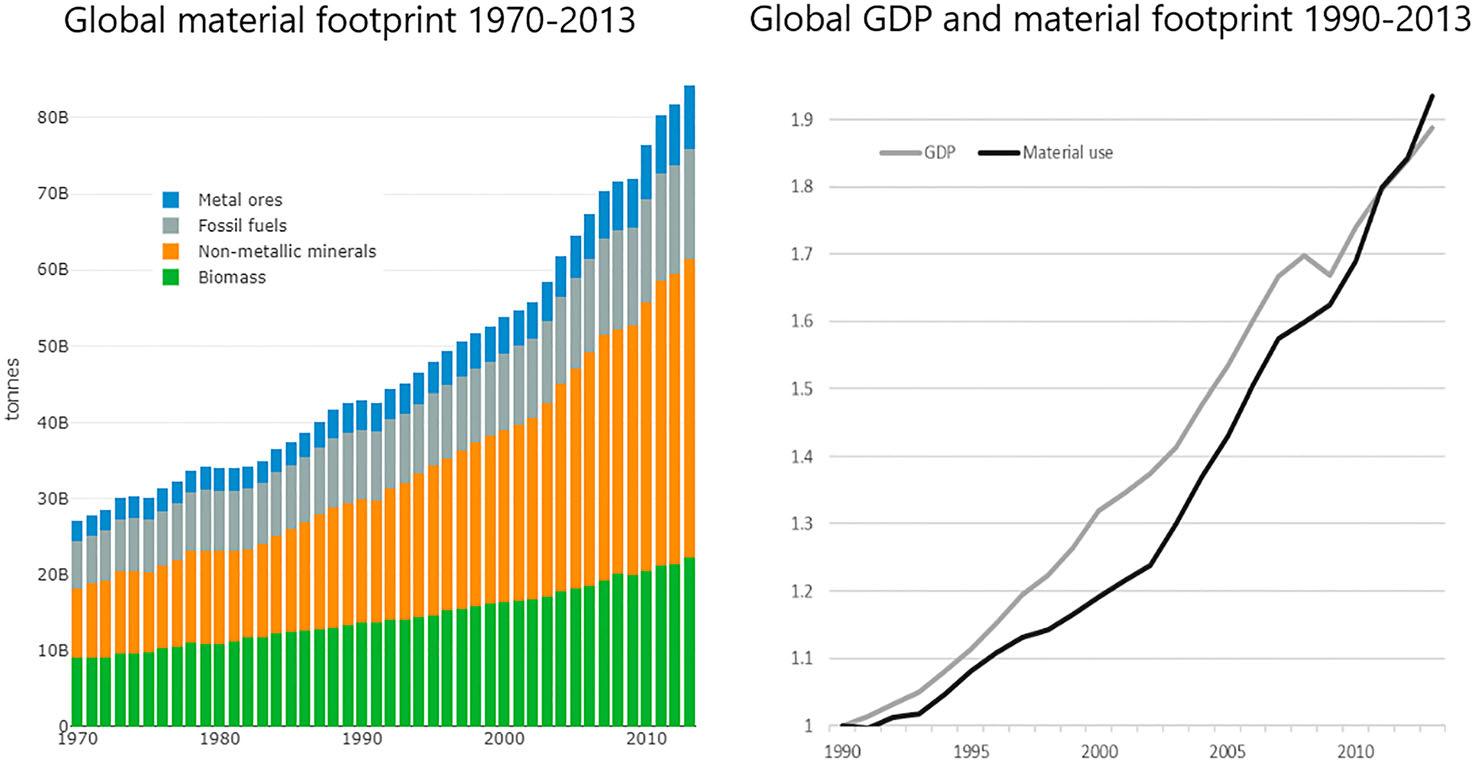

New Political Economy
ISSN: 1356-3467 (Print) 1469-9923 (Online) Journal homepage: https://www.tandfonline.com/loi/cnpe20
Is Green Growth Possible?
Jason Hickel & Giorgos Kallis
To cite this article: Jason Hickel & Giorgos Kallis (2019): Is Green Growth Possible?, New Political Economy, DOI: 10.1080/13563467.2019.1598964
To link to this article: https://doi.org/10.1080/13563467.2019.1598964

Published online: 17 Apr 2019.

Submit your article to this journal


Article views: 2

View Crossmark data

Full Terms & Conditions of access and use can be found at https://www.tandfonline.com/action/journalInformation?journalCode=cnpe20

IsGreenGrowthPossible?
JasonHickela andGiorgosKallisb
aAnthropology,Goldsmiths,UniversityofLondon,London,UK; bICREAandICTA-UAB,UniversitatAutonomade Barcelona,Barcelona,Spain
ABSTRACT
Thenotionofgreengrowthhasemergedasadominantpolicyresponseto climatechangeandecologicalbreakdown.Greengrowththeoryasserts thatcontinuedeconomicexpansioniscompatiblewithourplanet’s ecology,astechnologicalchangeandsubstitutionwillallowusto absolutelydecoupleGDPgrowthfromresourceuseandcarbon emissions.Thisclaimisnowassumedinnationalandinternational policy,includingintheSustainableDevelopmentGoals.Butempirical evidenceonresourceuseandcarbonemissionsdoesnotsupportgreen growththeory.Examiningrelevantstudiesonhistoricaltrendsand model-basedprojections,we findthat:(1)thereisnoempiricalevidence thatabsolutedecouplingfromresourceusecanbeachievedonaglobal scaleagainstabackgroundofcontinuedeconomicgrowth,and(2) absolutedecouplingfromcarbonemissionsishighlyunlikelytobe achievedataraterapidenoughtopreventglobalwarmingover1.5°C or2°C,evenunderoptimisticpolicyconditions.Weconcludethatgreen growthislikelytobeamisguidedobjective,andthatpolicymakersneed tolooktowardalternativestrategies.
Introduction
KEYWORDS
Sustainabledevelopment; ecologicaleconomics;green growth;degrowth; decoupling
ThenotionofgreengrowthemergedasacentralthemeattheRio+20ConferenceonSustainable Developmentin2012,andfeaturedprominentlyintheoutcomedocument TheWorldWeWant (UN 2012),whichcalledsimultaneouslyfora ‘greeneconomy’ and ‘sustainedeconomicgrowth’.Green growthhassincebecomeadominantresponsetoincreasinglyseriouswarningsaboutclimate changeandecologicalbreakdown(Dale etal. 2016).Asatheory,greengrowthassertsthatcontinued economicexpansion(asmeasuredbyGrossDomesticProduct,orGDP)isorcanbemadetobecompatiblewithourplanet’secology.WhilethisideahasbeenlatentintherhetoricofsustainabledevelopmentsincetheBrundtlandCommissionandthe firstRioConference,withearlyformulationstaking shapeundernameslikeEcologicalModernization(AyresandSimonis, 1993,Weizsäcker etal. 1998)or theEnvironmentalKuznetscurvehypothesis(Dasgupta etal. 2002),greengrowththeoryrendersitas aformalassertion.
Greengrowththeoryisnowpromotedbyleadingmultilateralorganisationsandisassumedin nationalandinternationalpolicy.ItrestsontheassumptionthatabsolutedecouplingofGDP growthfromresourceuseandcarbonemissionsisfeasible(e.g.Solow 1973),andatarate sufficienttopreventdangerousclimatechangeandotherdimensionsofecologicalbreakdown. Thisreviewpaperexaminesthisassumption,andtestsitagainstextantempiricalevidence.We ask:howdointernationalorganisationsdefinegreengrowth?Doesthetheoryofgreengrowth (andspecifically,theassumptionthatabsolutedecouplingofGDPgrowthfrommaterialthroughput
CONTACT JasonHickel j.hickel@gold.ac.uk
andcarbonemissionscanbeaccomplishedatasufficientlyrapidrate)withstandscrutinyinlightof existingdataandmodel-basedprojections?Andifnot,whataretheimplicationsforpolicy?
DefiningGreenGrowth
Therearethreemajorinstitutionalproponentsofgreengrowththeoryattheinternationallevel:the OECD,theUnitedNationsEnvironmentProgram(UNEP),andtheWorldBank.Eachpublished flagship reportsongreengrowtharoundthetimeoftheRio+20Conference.In2011,theOECDlauncheda greengrowthstrategytitled TowardsGreenGrowth.Thatsameyear,UNEPpublishedareporttitled TowardaGreenEconomy:PathwaystoSustainableDevelopmentandPovertyEradication.In2012,the WorldBankpublished InclusiveGreenGrowth:ThePathwaytoSustainableDevelopment.DuringtheRio +20Conference,theseinstitutionsjoinedwiththeGlobalGreenGrowthInstitutetocreatetheGreen GrowthKnowledgePlatformasaninstrumentforadvancinggreengrowthstrategyaroundtheworld.
Eachofthethreeorganisationsoffersadifferentdefinitionofgreengrowth.TheOECDdefinesitas ‘fosteringeconomicgrowthanddevelopmentwhileensuringthatnaturalassetscontinuetoprovide theresourcesandenvironmentalservicesonwhichourwell-beingrelies’ (2011,p.18).TheWorld Bank(2012)definesitas
economicgrowththatisefficientinitsuseofnaturalresources,cleaninthatitminimizespollutionandenvironmentalimpacts,andresilientinthatitaccountsfornaturalhazardsandtheroleofenvironmentalmanagement andnaturalcapitalinpreventingphysicaldisasters.
UNEPeschewsthelanguageofgreengrowthinfavourof ‘greeneconomy’,whichitdefinesasone thatsimultaneouslygrowsincomeandimproveshumanwell-being ‘whilesignificantlyreducing environmentalrisksandecologicalscarcities’ (2011,p.16).
Noneofthesedefinitionsareaspreciseaswemighthope(seeJacobs 2013).AsSmulders etal. (2014)pointsout,theconceptofgreengrowthis ‘newandstillsomewhatamorphous.’ TheWorld Bank’sdefinitionistheweakest.TheWorldBankseeksto ‘minimize’ theenvironmentalimpactof growth;butonecanminimiseenvironmentalimpactwithoutreducingimpactfromitspresent levels,andindeedwhilestillnonethelessincreasingoverallimpact.TheOECDisslightlystronger inthatitseeksto ‘maintain’ resourcesandenvironmentalservices,butheretoothereisno demandto reduce impact.TheUNEPreportoffersthestrongestdefinitioninthatitcallsforreducing environmentalimpactandecologicalscarcities,andfor ’rebuildingnaturalcapital’ .
Thethreeinstitutionsagreehoweveronthemechanismforachievinggreengrowth.Thepromiseis thattechnologicalchangeandsubstitutionwillimprovetheecologicalefficiencyoftheeconomy,and thatgovernmentscanspeedthisprocesswiththerightregulationsandincentives.Buttheydifferin theclarityoftheirclaims.TheWorldBankdoesnotaskwhetherpolicy-driveninnovationswillsuffice toreduceenvironmentalimpact.TheOECD,foritspart,clarifiesthatgreengrowthisonlypossibleif technologybecomesefficientenoughtoachieve ‘decoupling’ ofgrowthfromenvironmentalimpact. UNEPtakesthisastepfurther,andputsdecouplingatthecentreoftheanalysis:
Akeyconceptforframingthechallengeswefaceinmakingthetransitiontoamoreresourceefficienteconomyis decoupling.Asglobaleconomicgrowthbumpsintoplanetaryboundaries,decouplingthecreationofeconomic valuefromnaturalresourceuseandenvironmentalimpactsbecomesmoreurgent.
UNEPnotesthat ‘recenttrendsindicateamoderatetendencyofrelativedecouplingovertime’,but pointsoutthatthisisnotenough: ‘Thecentralchallenge istodecouplegrowthabsolutelyfrom materialandenergyintensity’ (UNEP 2011,p.15).
HereagainUNEPofferstheclearest – andstrongest – policy-orienteddefinitionofgreengrowth, namely,thatgreengrowthrequiresabsolutedecouplingofGDPfromresourceuseandenvironmentalimpact.Thisisinkeepingwiththeecologicalliterature,whichinsiststhatinacontextofecologicalovershoot(Rockström etal. 2009,Ceballos etal., 2015, 2017,Steffen etal. 2015),itisnot enoughtosimply ‘minimize’ environmentalimpact – wemustrapidlyreduceitdowntosafelimits.
Thisleavesuswiththequestion:Isabsolutedecouplingpossible,and,ifso,isitpossibleatarate sufficientforreturningtoandstayingwithinplanetaryboundaries?Noneofthethreereportson greengrowthprovideanyevidencethatitis.ButsincetheRio+20conference,anumberofkey studieshaveemergedtoshednewlightonthisquestion.Weoutlinethe findingsofthisempirical literatureinwhatfollows,lookingatthetwoprimarydimensionsofdecoupling – resourceuse andcarbonemissions – inturn,1 beforediscussingtheoreticalandpolicyimplications.
ResourceUse – IsAbsoluteDecouplingPossible?
Theconventionalmetricformeasuringaneconomy’sresourceuseis ‘domesticmaterialconsumption’ (DMC),whichisthetotalweightofrawmaterials(biomass,minerals,metalsandfossilfuels)extracted fromthedomesticterritory,plusallphysicalimportsminusallphysicalexports.WhileDMCisnota directindicatorofecologicalpressure,itisawell-establishedandwidely-usedproxyinthepolicyliteratureandenjoysrobustempiricalgroundingforthispurpose(Krausmann etal. 2009,p.2703).Van derVoet etal.(2004) findthatwhilethemass flowsofindividualmaterialsarenotindicativeoftheir ecologicalimpacts,andwhileimpactsvaryastechnologieschange,atan aggregate levelthereisa highdegreeofcorrelation(0.73)betweenmaterialthroughputandecologicalimpacts.
ToassesstherelationshipbetweenGDPandresourceuse,manygovernmentshaveadoptedthe practiceofdividingGDPbyDMC.Thisgivesanindicationofthe ‘resourceefficiency’ ofaneconomy.If GDPgrowsfasterthanDMC(relativedecoupling),theeconomyisbecomingmoreresourceefficient. GDP/DMCisusedbytheEuropeanUniontomonitorprogresstowardgreengrowth.Itisalsothe headlinemetricoftheOECD’sannual GreenGrowthIndicators report.
Bythismetric,itappearsthatmanynationshaveachievedrelativedecoupling,withGDPgrowing ataratefasterthanDMC.Inthe 2017 editionof GreenGrowthIndicators,theOECDconcludedthat ‘materialproductivityhasbeenimprovinginsomeOECDcountries’ (45).Thereportalsoindicates thatEuropeanOECDnationshaveachievedabsolutedecoupling,growingGDPwhilereducing DMC.Non-energymaterialconsumptionintheOECDdeclinedfrom12tonnespercapitain2000–10tonnespercapitain2015,withthedownwardtrendbeginningafterthe financialcrisisin2008 (itshouldbenoted,however,thattheOECD’sversionofDMCdoesnotincludefossilfuels;thisis notnormalpracticeintheliteratureonmaterial flows).Thesedataarekeytooptimisticgreen growthnarratives,andunderpinthepopularnotionthatwehavereached ‘peakstuff’ (e.g. Goodall, 2011,Pearce, 2012).
DMCisaproblematicindicator,however,asitdoesnotincludethematerialimpactinvolvedinthe productionandtransportofimportedgoods(Wiedmann etal 2015,Gutowski etal. 2017).Inaglobalisedeconomy,whererichcountrieshaveoutsourcedmuchoftheirproductiontopoorer countries,thissideofmaterialconsumptionhasbeenshiftedoff theirbalancesheet.Ifwebringit backin,lookingatthetotalresourceimpactofconsumptionbyanygivennation(whatWiedmann etal refertoas ‘materialfootprint’,orMF),thepicturechanges.Wiedmann etal showthatwhilethe USA,UK,Japan,theOECDandEU-27haveachievedrelativedecouplingofGDPfromDMC(including fossilfuels),materialfootprinthasbeenrisingatarateequaltoorgreaterthanGDP,suggestingno decouplingatall;indeed,inmostcasesre-couplinghasoccurred(see Figure1).TheOECD’s Green Growth Indicators partlyrecognisesthisproblem,stating ‘progressismoderateonceindirect flows associatedwithtradeareconsidered.’ Yetthereportdoesnotprovideanydataonindirect flows; andthedatathatisavailablesuggeststhatprogresshasbeennotmoderatebutnegative.
AccordingtoWiedmann etal.(2015),theonlysignificantcasesofrelativedecouplingofGDPfrom materialfootprinthavebeenChina,IndiaandSouthAfrica.SouthAfricaisthemostnotableofthe three,withnear-zerogrowthinmaterialfootprintsince1990,althoughnoevidenceofsustained absolutedecoupling.
Onaglobalscale,resourceusehasbeenrisingonasteadytrajectory.Krausmann etal.(2009)show thatglobalextractionandconsumptionofmaterials(includingfossilfuels)increased8-foldduring theperiod1900to2005,reaching59billiontonsperyear,growingatannualratesbetween1per

Figure1. MaterialusetrendsforEU-27,OECDandUSA,1990–2008.Source:Wiedmann etal.(2015).
centand4percent.Giljum etal. (2014) findthatglobalconsumptiongrewby93.4percentbetween 1980and2009,atanaveragerateof2.4percentperyear,toreachatotalof67.6billiontonnes.2 Materialflows.net(2015),whichisrunbytheViennaUniversityofEconomicsandBusiness,offers datafortheperiod1980to2013andshowsthatglobalmaterialfootprintgrew132percent,at anaveragerateof2.5percentperyear,toreachnearly85billiontons(Figure2(a)).
WhatistherelationshipbetweenglobalGDPandresourceuse?Krausmann etal.(2009)showthat duringthetwentiethcenturyGDPgrewatafasterrate(3percentperyear)thanresourceuse(2per centperyear).ThisrepresentsarelativedecouplingordematerialisationofGDPgrowth,atarateof about1percentperyear.Butthischangedinthetwenty-firstcentury:thegrowthrateofglobalconsumptionincreasedbetween2000and2005,averaging3.7percentperyear.Asthismatchedthe growthrateofGDP,nodecouplingwasachieved.Giljum etal. (2014)also findthatthegrowth rateofglobalconsumptionacceleratedinthetwenty-firstcentury,averaging3.4percentperyear between2000and2009;onceagain,nodecouplingwasachieved.Wiedmann’sglobaldatashows asimilartrend.Materialflows.net(2015)showsaperiodofmodestgrowthofglobalmaterialfootprint from1980to2002,at1.78percentperyear.AsthiswasslowerthantherateofGDPgrowth,some relativedecouplingwasachieved.However,the finaldecadefrom2002to2013showsanaccelerationofglobalmaterialuse,at3.85percentperyear.3 GlobalmaterialuserosemorequicklythanGDP duringthisdecade.Inotherwords,thematerialintensityoftheworldeconomyhasbeenincreasing inthetwenty-firstcentury,notdecreasing.Theauthorsstate: ‘Currently,theworldeconomyisthereforeonapathofre-materializationandfarawayfromany – evenrelative – decoupling.’ (Figure2(b)).
Insum:globalhistoricaltrendsshowrelativedecouplingbutnoevidenceofabsolutedecoupling, andtwenty-firstcenturytrendsshownotgreaterefficiencybutratherworseefficiency,withre-couplingoccurring.Ofcourse,futuretrajectoriescouldpotentiallybreakwiththesetrendsifwechange thecompositionandtechnologyoftheglobaleconomy(GrossmanandKrueger 1995).Whatdoes thedataaboutfutureprospectsshow?
Oneargumentisthatresourceintensitywilldiminishaseconomiesshiftfrommanufacturingto services.Historicaldatadonotsupportthistheory,however.AsaproportionofworldGDP,services havegrownfrom63percentin1997to69percentin2015,accordingtoWorldBankdata.Yetduring thissameperiodglobalmaterialusehasaccelerated,outstrippingglobalGDPgrowth.Thesameis trueofhigh-incomenations.Servicesrepresent74percentofGDPinhigh-incomenations(up from69percentin1997),butDMChasnotdiminishedandmaterialfootprintisoutpacingGDP growth.Thismaybebecauseservicesrequireresource-intensiveinputs(inotherwords,services embodysignificantamountsofmaterials),orbecausetheincomeacquiredfromsellingservicesis usedtopurchaseresource-intensiveconsumergoods(Kallis 2017).Anotherpossibilityisthatthe resourceintensityofprimaryandsecondarysectorshasincreasedtothepointofoutstrippingany gainsmadebyswitchingtoservices.Whateverthecausemaybe,thereisnohistoricalevidence thatswitchingtoserviceswill,inandofitself,reducethematerialthroughputoftheglobaleconomy.
Anotherargumentisthattechnologicalinnovationandgovernmentpolicymightdrivedecouplinginthefuture.ThisistheassumptionadvancedbytheWorldBank,OECDandUNEPgreen

Figure2. (a)Globalmaterialfootprint,1970–2013;(b)ChangeinglobalmaterialfootprintcomparedtochangeinglobalGDP (constant2010USD),1990–2013.Source:Materialflows.net/WorldBank.
growthreports.Toourknowledge,therearethreemajorstudiesthatexaminethispossibilityona globalscale.Wediscusstheir findingsbelow.
Dittrich etal. (2012)showthata ‘businessasusual’ scenariowillresultinmaterialuserisingfrom 68billiontonsin2008to180billiontonsin2050.ThisscenarioassumesthatglobalSoutheconomies growtothepointwhereglobalaveragepercapitaconsumptionin2030willequaltheOECD’sper capitaconsumptionin2008.Dittrich etal concludethatthislevelofresourceuseis ‘notanoption forthefuture’.Bycontrast,theiroptimisticscenarioassumes(a)mediumpopulationgrowth;(b) thatallcountriesfollowbestpracticeinefficientresourceuse;and(c)thatreductionofconsumption ofonematerialdoesnotrequirehigherconsumptionofanother.Inthisscenario,resourceuse reaches93billiontonsby2050.Thisrepresentsrelativedecoupling,butnoabsolutereductionin materialuse.
Inasecondstudy,Schandl etal.(2016)useamodelbasedon3percentaverageannualglobal GDPgrowthandexplorethreescenariosbetween2010and2050.Thereferencescenario,withno significantchangetoenvironmentalpolicies,showsthatglobalresourceusegrowsfrom79.4 billiontonnesin2010to183billiontonsin2050(similartotheDittrich etal projection),with slightrelativedecoupling.The ‘mediumefficiency’ scenario,withacarbonpriceof$25pertonof CO2 (risingby4percentperyear),showsthatglobalresourceusestillgrowssteadilyoverthe period,butatabouthalftherateofglobalGDP,reaching130billiontonsby2050.The ‘high efficiency’ scenario,withacarbonpricestartingat$50(risingby4percentperyearto$236by 2050)plusadoublinginthematerialefficiencyoftheeconomy(fromhistoricalaverageimprovementsof1.5percentperyearupto4.5percentperyear),showsthatglobalresourceusestill growssteadily,butataboutone-fourththerateofglobalGDP,reaching95billiontonsin2050 (again,similartoDittrich etal).
ItisimportanttonotethattherateofmaterialefficiencyimprovementsthatSchandl etal assume (viz.,4.5percentperyear)hasnoempiricalbasis.Theyprovidenoevidencethatsucharapidrateis possibletosustain.Yetevenwiththisoptimisticassumption,Schandl etal conclude: ‘Ourresearch showsthatwhilesomerelativedecouplingcanbeachievedinsomescenarios,nonewouldlead toanabsolutereductionin … materialsfootprint.’
Finally,UNEPhasdevelopedamodelthatexploresfourdifferentfuturescenarios,whichthey discussintheir2017report AssessingGlobalResourceUse (UNEP 2017a,pp.42–45).Theirreference scenario,extrapolatingfromexistingtrends,showsthatglobalresourceuserisessteadilyfrom85
billiontonsin2015to186billiontonsby2050(similartoDittrich etal andSchandle etal).Theirhigh efficiencyscenario,bycontrast,includesstrongpolicymeasures:(a)aglobalcarbonpriceof$5per tonofCO2ein2021,risingby18.1percentperyearto$573in2050;(b)technologicalinnovationthat improvesresourceefficiency;(c)aresourceextractiontaxthatincreasesthepriceofnaturalresources relativetootherinputs;and(d)progressivechangestogovernmentregulations,planningandprocurementpolicies(forfulldetailsofthemodelseeUNEP 2017b,p.287 ff).Thehighefficiencyscenario projectsthatglobalresourceuserisesto132billiontonsin2050.Whilesomerelativedecouplingis achieved,thereisnoabsolutereductioninresourceuse.
TheUNEPprojectionsaresignificantlyworsethaneitherDittrich etal orSchandl etal predict.The model’sauthors,EkinsandHughes,saythisbecausetheyhaveincorporatedthe ‘reboundeffect’ into theirmodel(UNEP 2017a,106 ff.).Thereboundeffectcancelsoutsomegainsinresourceefficiency. Thishappensbecausesuchgainsreducethecostofagoodorservice,freeingupincomeandincreasingeffectivedemand(seeHerringandSorrell 2009 forareviewoftheliterature).Inlightofthese findings,UNEPacknowledgesthatimprovementsinresourceefficiencywillnotbeenough,inand ofthemselves,toachievesustainability,orgreengrowth. ‘Resourceefficiencyaloneisnotenough. Productivitygainsintoday’slinearproductionsystemarelikelytoleadtoincreasedmaterial demandthroughacombinationofeconomicgrowthandreboundeffects’ (12).Instead,thereport acknowledgesthatsomethingelseisneeded.Theysuggestfurtherinvestigationintotheprinciples ofacirculareconomy: ‘amovefromlineartocircularmaterial flowsthroughacombinationof extendedproductlifecycles,intelligentproductdesignandstandardization,reuse,recyclingand remanufacturing’ (12).Improvingcircularitycouldreducetheecologicalimpactofmaterialthroughput,butonlyasmallfractionoftotalthroughputhascircularpotential.44percentiscomprisedof foodandenergyinputs,whichareirreversiblydegraded,and27percentisnetadditiontostocksof buildingsandinfrastructure(Haas etal. 2015).
Thesemodelssuggestthatabsolutedecouplingisnotfeasibleonaglobalscaleinthecontextof continuedeconomicgrowth.Theseareglobalstudies,however.Onemightarguethatwhenitcomes tothequestionofwhethergreengrowthispossible,weneedtolookspecificallyatwhathighincomenationsmightbeabletoachieve,giventheirgreatercapacityfortechnologicaldevelopment.
Hatfield-Dodds etal. (2015)havemodelledanumberofscenariosforAustraliafrom2015to2050, withresultsthathavebeenwidelycitedinsupportofgreengrowththeory.Theirmostoptimistic scenarioassumeshighlevelsofpolicy-drivenefficiencygains,withanoverall70percentdropin materialintensity.They findthat ‘substantialeconomicandphysicaldecouplingispossible,’ with GDPincreasingatanaveragerateof2.41percentperyear ‘whileassociatedenvironmentalpressures ease(greenhousegasemissions,waterstress,nativehabitatloss)’ Themodelsuggeststhatthiscan beaccomplishedwithoutoutsourcingenvironmentalimpacttoothercountries.
Hatfield-Dodds etal havecomeundercriticismforthismodel,however.First,theyprovidenoevidencefortheirassumptionthata70percentdropinmaterialintensityispossible.Alexander etal. (2018)havepointedoutthatthisrateofefficiencyimprovementisbaselessandunrealistic.Indeed, theAustralianBureauofAgriculturalEconomics(ABARE 2008)reportsthatefficiencyislikelyto improvebyonly0.2percentto0.5percentperyearintothefuture – atmostone-eighthofthe ratethatHatfield-Doddsassume.Second,evenifa70percentdropinmaterialintensitywaspossible, itappearsthatanyresultingdecreaseinresourceusemayonlybeachievedovertheshortterm.The optimisticscenariointheHatfield-Doddsetalmodelshowsthatmaterialusedeclinesfrom2015to 2040,butbeginstoincreaseagainthereafter.
Ward etal.(2016)havetestedtheHatfield-Doddsmodeloveralongerperiod,to2100.They assumeadropinmaterialintensityby2050thatis50percentmorethanHatfield-Dodds etal propose,foranevenmoreoptimisticscenario.They findthatmaterialextractiondeclinesuntil 2050(decouplingatanaveragerateofabout4percentperyear)butthen flattensoff andrisessteadilysothatby2100materialuseis20percentto60percenthigherthanitsinitialvaluein2015. Whileabsolutedecouplingfrommaterialextractionisachievedintheshortterm,inthelonger termmaterialextractionrisesby2.16percentperyear,nearlymatchingtherateofGDPgrowth.

Figure3. ProjectionsformaterialextractioninAustraliaunderhighlyoptimisticconditions,2015–2100.Greendotsrepresentthe Hatfield-Doddsprojectionto2050.Source:Ward etal.(2016).
Notethattheindicator ‘materialextraction’ isdifferentfrombothDMCandmaterialfootprint,inthat itdoesnotincludeimports;the figuresforDMCandmaterialfootprintforAustraliawouldbesignificantlyhigher(Figure3).
Ward etal.(2016)arguethatthisresurgenceinmaterialextractionhappensbecauseresource efficiencycannotimproveforever,aseventuallyitapproachesphysicallimits.Theystate:
Fornon-substitutableresourcessuchasland,water,rawmaterialsandenergy,wearguethatwhilstefficiency gainsmaybepossible,thereareminimumrequirementsfortheseresourcesthatareultimatelygovernedby physicalrealities:forinstancethephotosyntheticlimittoplantproductivityandmaximumtrophicconversion efficienciesforanimalproductiongoverntheminimumlandrequiredforagriculturaloutput;physiological limitstocropwateruseefficiencygovernminimumagriculturalwateruse,andtheupperlimitstoenergyand materialefficienciesgovernminimumresourcethroughputrequiredforeconomicproduction.
Asthephysicallimitsofresourceefficiencyarereached,continuedGDPgrowthdrivesresourceuse backup.Ward etal concludethat ‘decouplingofGDPgrowthfromresourceuse,whetherrelativeor absolute,isatbestonlytemporary.Permanentdecoupling(absoluteorrelative)isimpossiblefor essential,non-substitutableresourcesbecausetheefficiencygainsareultimatelygovernedbyphysicallimits.GrowthinGDPultimatelycannotplausiblybedecoupledfromgrowthinmaterialand energyuse,demonstratingcategoricallythatGDPgrowthcannotbesustainedindefinitely.Itisthereforemisleadingtodevelopgrowth-orientedpolicyaroundtheexpectationthatdecouplingis possible.’
ConclusionsandDiscussion
TheempiricaldatasuggestthatabsolutedecouplingofGDPfromresourceuse(a)maybepossiblein theshortterminsomerichnationswithstrongabatementpolicy,butonlyassumingtheoretical efficiencygainsthatmaybeimpossibletoachieveinreality;(b)isnotfeasibleonaglobalscale, evenunderbest-casescenariopolicyconditions;and(c)isphysicallyimpossibletomaintaininthe longerterm.Inlightofthisdata,wecanconcludethatgreengrowththeory – intermsofresource use – lacksempiricalsupport.Wearenotawareofanycredibleempiricalmodelsthatcontradict thisconclusion.Therearethreecounterpointstoconsider,however:
First,thisconclusionissensitivetothebaselinerateofGDPgrowth.Thestudiescitedabove projectgrowthat2–3percentperyear.Asthegrowthrateapproacheszero,absolutedecoupling becomesmorefeasible,andislikelytolastlonger.Itisreasonabletoexpectthatgreengrowth couldbeaccomplishedatverylowGDPgrowthrates,i.e.lessthan1percentperyear – significantly lowerthanhistoricaltrendsandprojectedpathways.4
Second,thestudiescitedabovearebasedontheexistingrelationshipbetweenGDPandmaterial throughput.Theymodeltheimpactofknownvariables,suchasefficiencyimprovements,
technologicalinnovation,taxes,shiftstoservices,etc.However,onemightarguethatitistheoreticallypossibletobreaktheexistingrelationshipbetweenGDPandmaterialthroughputaltogether. Wereflectonthisinthepenultimatesectionofthispaper.
Third,onemightarguethattheaggregatematerialfootprintindicatorobscuresthepossibilityof shiftingfromhigh-impactresourcestolow-impactresources.Itistruethatdifferentmaterialshave differentimpacts,andthatrenewableandnon-renewablematerialshavedifferentkindsofsustainabilitythresholds,buttheaggregatemeasureisnonethelessregardedasausefulproxybecauseallof theconstituentmaterialcategoriesexhibitroughlythesametrendsasthetotal(i.e.theyallincrease withGDPgrowth).Andbecauseallmaterialshave some impact,indefinitegrowthofanymaterialcategoryisnotcompatiblewithecologicalprinciples.
Itisimportanttopointoutthatthestandardforgreengrowthwehaveusedaboveisaconservativeone,inasmuchasitregards any reductionofannualresourceuse,howeversmall,asgreen.The academicliteratureonresourceuseissignificantlymorestringentthanthis.Anemergingconsensus holdsthatglobalmaterialfootprintneedstobereducedto50billiontonsperyearinordertobe compatiblewiththeplanet’secology(Dittrich etal., 2012,HoekstraandWiedmann 2014,UNEP 2014,Bringezu 2015).Bringezu(2015)goesfurtherandsuggeststhatthisreductionneedsto happenby2050.Ofcourse,therearereasonstobeskepticalofglobaltargetslikethis,asthey combinerenewableandnon-renewablematerialsthatshouldbetreatedseparately,andbecause theimpactsofmaterialusearelocallyspecificandthresholdsshouldbetailoredtolocalecosystems (exceptinthecaseoffossilfuelsandland-basedbiomassextraction,whichaffectgreenhousegas emissions).Still,theliteratureisclearthatmaterialfootprintneedstobescaleddownsignificantly frompresentlevels.Inotherwords,tobetrulygreen,greengrowthrequiresnotjust any degree ofabsolutedecoupling,butabsolutedecouplingthatisrapidenoughtomeetecologicaltargets.
CarbonEmissions – IsGrowthCompatiblewiththeParisAgreement?
Unlikewithresourceuse,thereisasteadylong-termtrendtowardrelativedecouplingofGDPfrom carbonemissions,andweknowthatabsolutereductionsincarbonemissionsarepossibletoachieve. Whenitcomestoclimatechange,however,theobjectiveisnotsimplytoreduceemissions(amatter of flows),buttokeeptotalemissionsfromexceedingspecificcarbonbudgets(amatterofstocks).For greengrowththeory,then,thequestionisnotonlywhetherwecanachieveabsolutedecouplingand reduceemissions,butwhetherwecanreduceemissionsfastenoughtostaywithinthecarbon budgetsfor1.5°Cor2°C,aspertheParisAgreement,whilestillcontinuingeconomicgrowth.
Anumberofhigh-incomecountrieshaveseendecliningemissionsinthetwenty-firstcentury, despitecontinuedeconomicgrowth. Figure4(a)showsdecliningemissionsintheUSandEU28,in bothterritorialandconsumption-basedterms,from2006to2016(i.e.absolutedecoupling). However,emissionsfromtheglobalSouthhavecontinuedupward,albeitataslowerratethan GDP(i.e.relativedecoupling).China’semissionsdeclinedslightlybetween2014and2016(abrief periodofabsolutedecoupling),beforegrowingagainin2017.
Onagloballevel,CO2 emissionshaveincreasedsteadily,fallingonlyduringperiodsofeconomic recession(Figure4(b)).Globalemissionsdidleveloff in2015and2016whileGDPcontinuedtorise, promptingtheInternationalEnergyAgency,aresearcharmoftheOECD,toannounce ‘Decouplingof globalemissionsandeconomicgrowthconfirmed’ (IEA 2016),whilemediaoutletscelebrated ‘peak emissions’ (Meyer 2016).Thisnewsbrieflycametoconstituteakeyelementofoptimisticgreen growthnarratives,untilglobalemissionsbegantoriseagainin2017(1.6percent)and2018(2.7 percent).AnalystsattributethetemporaryplateautoashiftinChinaawayfromcoaland(mostly) towardoilandgas,andashiftintheUStonaturalgas.5 Oncetheseshiftswerecomplete,continued economicgrowthdroveemissionsupagain.
Overall,globalcarbonproductivityhasbeenslowing.WorldBankdatashowsthatcarbonproductivity(CO2 per2010$USGDP)improvedsteadilyfrom1960to2000,withdecarbonisationhappeningatanaveragerateof1.28percentperyear(relativedecoupling).However,from2000to

Figure4. (a)AnnualterritorialandconsumptionCO2 emissionsforselectregions,1990–2016;(b)GlobalCO2 emissions1960–2018. Source:GlobalCarbonBudget(2018).
2014therewasnoimprovementincarbonproductivity – inotherwords,notevenrelativedecouplinghasbeenachievedinthetwenty-firstcentury.6 High-incomenationshavedonebetter,at leastintermsofterritorialemissions(theWorldBankdoesnottrackconsumption-basedemissions), butevensoprogresshasslowed,fromanaveragerateof1.91percentperyearfrom1970to2000, downto1.61percentperyearfrom2000to2014.
ExistingtrendsareincompatiblewiththeParisAgreementtargets.Business-as-usualissettolead to4.2°Cofwarming(2.5°Cto5.5°C)by2100.EvenwiththeNationallyDeterminedContributionsand IntendedNationallyDeterminedContributionsundertheParisAgreement,globalwarmingisstill projectedtoreach3.3°C(1.9°Cto4.4°C) – animprovementovertheBAUscenariobutstillfarexceedingthe1.5°Cand2°Cthresholds.7 Inordertokeepwarmingbelowthesethresholds,theworldwill havetomakemuchmoreaggressiveemissionsreductions.
TheIPCC’sFifthAssessmentReport(AR5)includes116mitigationscenariosthatareconsistent withRepresentativeConcentrationPathway2.6(RCP2.6),whichoffersthebestchancesofstaying below2°C.Allofthesescenariosaregreengrowthscenariosinthattheystabiliseglobaltemperatures whileglobalGDPcontinuestorise.RisingGDPisabuilt-infeatureoftheSharedSocio-EconomicPathways(SSPs),whichformthebasisfortheIPCCmitigationscenarios(Kuhnhenn 2018).AR5warns, however,thatthesescenarios ‘typicallyinvolvetemporaryovershootofatmosphericconcentrations’ and ‘typicallyrelyontheavailabilityandwidespreaddeploymentofbioenergywithcarboncapture andstorage(BECCS)’ (2014,p.23).Indeed,thevastmajorityscenariosfor2°C(101ofthe116)relyon BECCStothepointofachievingnegativeemissions.8 BECCSentailsgrowinglargetreeplantationsto sequesterCO2 fromtheatmosphere,harvestingthebiomass,burningitforenergy,capturingtheCO2 emissionsatsourceandstoringitunderground.Relyingonthese ‘negativeemissionstechnologies’ allowsforamuchlargercarbonbudget(aboutdoubletheactualsize)byassumingthatwecansuccessfullyreduceglobalatmosphericcarboninthesecondhalfofthecentury.
BECCSishighlycontroversialamongclimatescientists.Itwas firstproposedbyObersteiner etal. (2001)andKeith(2001)attheturnofthecentury.IPCCmodellingteamsbeganincludingitintheir scenariosfrom2005,despitehavingno firmevidenceofitsfeasibility.WiththepublicationofAR5, BECCSwasenshrinedasadominantassumption.Obersteinerhasexpressedalarmattherapid uptakeofhisidea;heconsidersBECCStobewhathecallsa ‘risk-managementstrategy’,ora ‘backstoptechnology’ incaseclimatefeedbackloopsturnouttobeworsethanexpected,andsaysthe IPCChas ‘misused’ itbyincludingitinregularscenariostotakepressureoff ofconventionalmitigationpathways(i.e.emissionsreductions)(Hickman 2016).InKeith’s(2001)initialformulationofthe idea,henotedthatwhile ‘measureduse’ ofbiomasscouldhelpmitigateenvironmentalproblems, ‘largescaleuseofcroppedbiomasswillnot.’
AndersonandPeters(2016)pointoutthatthe ‘allure’ ofBECCSisduetothefactthatitallows politicianstopostponetheneedforrapidemissionsreductions: ‘BECCSlicensestheongoingcombustionoffossilfuelswhileostensiblyfulfillingtheParisCommitments.’ Thereareanumberofconcerns.First,theviabilityofpowergenerationwithCCShasneverbeenproventobeeconomically viableorscalable;itwouldrequiretheconstructionof15,000facilities(Peters 2017).Second,the scaleofbiomassassumedintheAR5scenarioswouldrequireplantationscoveringlandtwoto threetimesthesizeofIndia,whichraisesquestionsaboutlandavailability,competitionwithfood production,carbonneutrality,andbiodiversityloss(Smith etal. 2016;Heck etal. 2018).Third,the necessarystoragecapacitymaynotexist(DeConinckandBenson 2014,GlobalCCSInstitute 2015).AndersonandPetersconcludethat ‘BECCSthusremainsahighlyspeculativetechnology’ andthatrelyingonitistherefore ‘anunjustandhighstakesgamble’:ifitisunsuccessful, ‘society willbelockedintoahigh-temperaturepathway.’ Thisconclusionissharedbyagrowingnumber ofscientists(e.g.Fuss etal. 2014,VaughanandGough, 2016,Larkin etal. 2017,VanVuuren etal. 2017),andbytheEuropeanAcademies’ ScienceAdvisoryCouncil(2018).
ItisnotclearthatwecanjustifiablyrelyonBECCS,anunproventechnology,tounderwritegreen growththeory.Ifweacceptthispoint,thenwemustreturntoaskingwhetheritispossibletomaintaingrowthwithoutrelyingonBECCStostaywithinthecarbonbudgetsconsistentwiththeParis Agreement.WithoutBECCS,globalemissionsneedtofalltonetzeroby2050for1.5°C,orby2075 for2°C.9 Thisentailsreductionsof6.8percentperyearand4percentperyear,respectively (Figure5).Theoretically,thiscanbeaccomplishedwith(a)arapidshiftto100percentrenewable energytoeliminateemissionsfromfossilfuelcombustion(JacobsonandDelucchi 2011);plus(b) afforestationandsoilregenerationtoeliminateemissionsfromlandusechange;plus(c)ashiftto alternativeindustrialprocessestoeliminateemissionsfromtheproductionofcement,steel,and plastic.Thequestionis,canallofthisbeaccomplishedquicklyenough?
Only6ofthe116scenariosfor2°CinAR5excludeBECCS.Theseworkbyassuming ‘optimalfull technology’ inallotherareas,plusmassafforestation,andwithhighmitigationcosts.Theserepresent theoreticallypossiblepathways,butwithoutanyempiricalevidenceastotheirfeasibility.
Resultsofempiricalstudiesarenotpromising.Schandl etal.(2016)modelwhatmightbeachieved withaggressivemitigationpolicies,withoutrelyingonBECCS.Theirhigh-efficiencyscenariohasa carbonpricestartingat$50perton(risingby4percentperyearto$236by2050)plusadoubling inthematerialefficiencyoftheeconomyduetotechnologicalinnovations(improvingfromahistoricalaveragerateof1.5percentperyearupto4.5percent).Schandl etal providenoevidenceforthe feasibilityoftheefficiencyimprovementsthattheyassume.Evenso,theresultshowsthatwithglobal growthof3percentperyear,annualemissionsplateauto2050butdonotdecline.Inthisscenario,

Figure5. CO2 mitigationscurvesfor1.5°Cand2°C.Source:GlobalCarbonBudget(2018).
growthinenergydemandoutstripstherateofdecarbonisation,violatingthecarbonbudgetsfor 1.5°Cand2°C.
TheInternationalRenewableEnergyAssociation(IRENA 2018)havemodelledascenarioforcontinuedGDPgrowthcompatiblewith2°Cbyrelyingonarapidshifttorenewableenergy(consistent withJacobsonandDelucchi 2011).Thescenariorequiresadding12,200GWofsolarandwind capacityby2050,withadramaticincreaseininstallationrates(2.3to4.6timesfasterthanthe present).10 Thescenarioalsorequiresthattheenergyintensityoftheglobaleconomyfallsbytwothirds(by2.8percentperyear,doublethehistoricalrate),loweringenergydemandin2050to slightlylessthan2015levels.11 Thisisfeasibleinasmuchasthetransitiontowindandsolaritself improvesenergyefficiency(JacobsonandDelucchi 2011).12 Still,eventhisoptimisticscenarioaccomplishesonly90percentofthenecessaryemissionsreductionsfor2°C(likelybecauseitpaysnoattentiontoemissionsfromlandusechangeandcementproduction).Themodelreliesonnegative emissionstechnologytocovermostoftheremainder.
VanVuuren etal.(2018)consider ‘alternativepathways’ formeetingtheParisAgreementtargets withoutrelyingonwidespreaduseofnegativeemissionstechnologies.TheymodelrisingGDPin accordancewithSSP2.Inadditiontoacarbontaxandotheraggressivemitigationstrategies,their optimisticscenarioincludesthefollowingsettings:globalpopulationpeaksat8.4billionin2050 anddeclinesto6.9billionby2100;meatconsumptiondeclines80percentby2050;allnewcars andairplanesareefficientfrom2025;theworldshiftstothemostefficienttechnologiesforsteel andcementproduction,etc.Evenwiththesehighlyoptimisticassumptionsinplace,they findthat thepressuresofcontinuedgrowthdriveemissionstoexceedthecarbonbudgetsfor1.5°Cand 2°C,withoutnegativeemissionstechnologies.
Anotherwaytoapproachthisquestionisbylookingatprojectedratesofdecoupling.Ifweassume globalGDPcontinuestogrowat3percentperyear(theaveragefrom2010to2014),thendecouplingmustoccuratarateof10.5percentperyearfor1.5°C,or7.3percentperyearfor2°C.Ifglobal GDPgrowsat2.1percentperyear(asPWCpredicts),thendecouplingmustoccurat9.6percentper yearfor1.5°C,or6.4percentperyearfor2°C.Allofthesetargetsarebeyondwhatexistingempirical modelsindicateisfeasible.TheSchandl etal modelindicatesthatdecouplingcanhappenbyatmost 3percentperyearunderoptimisticconditions.Othermodelsarriveatsimilarconclusions.Before adoptingBECCSassumptions,theIPCC(2000)projecteddecouplingof3.3percentperyearina globalbest-casescenario.TheC-ROADStool(developedbyClimateInteractiveandMITSloan)projectsdecouplingofatmost4percentperyearunderthemostaggressivepossibleabatementpolicies:highsubsidiesforrenewablesandnuclearpower,plushightaxesonoil,gasandcoal.Allof theseresultsfallshortofthedecouplingratethatmustbeachievediftheglobaleconomycontinues togrowatexpectedrates.Holz etal. (2018) findthatifweruleoutwidespreaduseofnegativeemissionstechnologies,therequiredrateofdecarbonisationformeetingtheParisAgreementis ‘well outsidewhatiscurrentlydeemedachievable,basedonhistoricalevidenceandstandardmodelling.’
Thechallengeisevenmoredifficultforrichnations.AndersonandBows(2011)havemodelledthe emissionsreductionsnecessaryforachievinga50percentchanceofstayingunder2°C(morerelaxed thanthetwo-thirdschancethattheUNFCCcallsfor),withoutBECCS.Theyproceedfromtheprinciple of ‘commonbutdifferentiatedresponsibility’,wherebyrichnations(Annex-1nations)makemore aggressiveemissionsreductionsthanpoornations,owingtotheirgreaterhistoricalresponsibility foremissionsandtheirgreatercapacityformanagingthecostsoftransition.Theyassumethat Non-Annex1nationsdeferpeakemissionsuntil2025,andthereafterreduceemissionsby7per centperyear.Theyacknowledgethattheseareextremelyambitiousassumptionsbutconsider themtobethemostfeasiblecompromisebetweenpracticalityandequity.Tostaywithintheremainingcarbonbudget,Annex1nationsneedtoreduceemissionsby8–10percentperyear,beginningin 2015.Thismodelwasdevelopedwithdataupto2010;astheremainingcarbonbudgetisnow smaller,AndersonestimatesthatAnnex1nationsneedtoreduceemissionsby12percentperyear.13
IfweacceptthatAnnex1nationsneedtoachieveemissionsreductionsof12percentperyear, andifweassumethatGDPgrowthinAnnex1nationscontinuesat1.86percentperyear(the
averagefrom2010to2014),thendecouplingmustoccuratarateof15.8percentperyear.14 For perspective,thisiseighttimesfasterthanthehistoricrateofdecouplinginAnnex1nations(viz., 1.9percentperyearfrom1970to2013),anditisimportanttobearinmindthattherateofdecouplinghasgenerallyslowedoverthisperiod.15 Italsoexceedsthedecouplingrateimpliedbythe averageG20NationallyDeterminedContributionsundertheParisAgreement(viz.,3percentper year)byafactorof five.
Thereisoneempiricalmodelthatfeasiblyaccomplishesemissionsreductionsconsistentwiththe ParisAgreement,withoutrelyingonnegativeemissionstechnologies.PublishedbyGrubler etal. (2018),itwasincludedintheIPCCSpecialReporton1.5°C(2018)inresponsetogrowingcritiques oftheIPCC’srelianceonBECCS.Thescenario,knownas ‘LowEnergyDemand’ (LED),accomplishes emissionsreductionscompatiblewith1.5°Cbyreducingglobalenergydemandby40percentby 2050.Inadditiontodecarbonisationandafforestation,thekeyfeatureofthisscenarioisthat globalmaterialproductionandconsumptiondeclinessignificantly: ‘Theaggregatetotalmaterial outputdecreasesbycloseto20percentfromtoday,one-thirdduetodematerialization,andtwothirdsduetoimprovementsinmaterialefficiency.’ Dematerialisationisaccomplishedbyshifting awayfromprivateownershipofkeycommodities(likecars)towardssharing-basedmodels.LED differentiatesbetweentheglobalNorthandSouth.Industrialactivitydeclinesby42percentin theNorthand12percentintheSouth.Withefficiencyimprovements,thistranslatesintoindustrial energydemanddecliningby57percentintheNorthand23percentintheSouth.
TheLEDscenarioprojectscontinuedGDPgrowthatjustover2percentperyear,whichwould makeitconsistentwithgreengrowththeory.However,theempiricalbasisforthisGDPtrendis notrobust.ItisderivedfromtheMESSAGE-Globiummodel,whichcalculatesGDPfromonlytwo inputs:laboursupply(populationsizeandproductivity)andenergy.Thelowenergydemandin theLEDscenariodoesnotaffectgrowthbecauseitisoffsetbyefficiencyimprovements.Asthe modelisinsensitivetochangesinmaterialthroughput,reductionsinproductionandconsumption donotaffectoutput.ThepaperoffersnoevidencethatGDPwillcontinuetogrowdespitesuch reductions.CharlieWilson,oneofthepaper’sauthors,acknowledgedthat ‘wedidnotconsider broaderquestionsofGDPgrowthordegrowth,andwedidnotexplicitlyreportrelationships betweenourscenarioandGDPoutcomesforthisreason.’16
Conclusionsanddiscussion
TheempiricaldatademonstratethatwhileabsolutedecouplingofGDPfromemissionsispossible andisalreadyhappeninginsomeregions,itisunlikelytohappenfastenoughtorespectthe carbonbudgetsfor1.5°Cand2°Cagainstabackgroundofcontinuedeconomicgrowth.Growth increasesenergydemand,makingthetransitiontorenewableenergymoredifficult,andincreases emissionsfromlandusechangeandindustrialprocesses.Modelsthatdoprojectgreengrowth withintheconstraintsoftheParisAgreementrelyheavilyonnegativeemissionstechnologiesthat areeitherunprovenordangerousatscale.Withoutthesetechnologies,theratesofdecarbonisation requiredfor1.5°Cor2°Caresignificantlysteeperthanextantmodelssuggestisfeasibleevenwith aggressivemitigationpolicies.
Thisconclusionchangessomewhatifweadjustthebaselinegrowthrate.Allofthestudiescited aboveprojectglobalGDPgrowthat2–3percentperyear.Alowerrateofgrowthrequiresalower rateofdecarbonisation.Agrowthrateof0percentrequiresdecarbonisationof6.8percentperyear (for1.5°C)and4percentperyear(for2°C).Thereisnoempiricalevidencethat6.8percentcanbe achievedonaglobalscale,but4percentisnearlywithinreach.Inotherwords,itisempiricallyfeasibletoachievegreengrowthwithinacarbonbudgetfor2°Cwiththemostaggressivepossiblemitigationpolicies if thegrowthrateisveryclosetozeroand if mitigationstartsimmediately.This conclusionisinlinewithresearchbySchroderandStorm(2018),which findsthatreducingemissions inlinewiththe2°Ctargetisfeasible(underoptimisticassumptions)onlyifglobaleconomicgrowthis
lessthan0.45percentperyear.Thisconclusiondoesnotholdfor1.5°C,however;emissions reductionsinlinewith1.5°Carenotempiricallyfeasibleexceptinade-growthscenario.
TheoreticalPossibilities
AsJohnO’Neill(2017)writes,whereas
itislogicallypossibletohaveincreasingGDPandadecreasingphysicalandenergythroughputinaneconomy … itisafallacytomovefromclaimsaboutwhatislogicallypossibletoclaimsaboutwhatisphysicallypossibleand anotherfromwhatisphysicallypossibletowhatisempiricallyactual.
Greengrowth,wehaveshown,isnotempiricallyactual – butisitpossible intheory?
ThisquestionisoftenapproachedintermsoftheIPATequation(EnvironmentalImpact=Population*Affluence*Technology),whichsaysthatthe impact ofaneconomy(e.g.tonsofCper capita)isequaltothe scale oftheeconomy(GDPpercapita)timesits efficiency (e.g.GDPpertons ofcarbon).Efficiencyisinprincipledeterminedbytechnologyandpolicyandthereisno apriori reasonwhyitcannotincreasefasterthanscale,orevenasfastasnecessarytoreduceimpacttoa sustainablelevel.Furthermore,insofarasGDPmeasureswhatpeoplearewillingtopayforthings, asopposedtotheamountofenergyandresourcespeopleconsume,thereisnoreasonwhythe economycannotintheorygrowusingprogressivelylessenergyandresources:peoples’ preferences mayshifttogoodsandserviceswithever-lowerenergyandmaterialrequirements.Onemayconcludethenthatabsolutedecouplingshouldtheoreticallybepossible – andinfactthisisprecisely thereasonthatadvocatesofgreengrowtharenotdeterredbyclaimsthatithasnothappened yetanddoesnotseemlikelytohappeninthefuture.Theyattributethistolackofeffort.
Ward etal. ’s(2016)studyprovidesperhapsthemostcompellingcounter-argumenttothisclaim. Asthereisathermodynamicallydefinedmaximumofefficiency,indefinitegrowthwillsoonerorlater leadtoincreaseinresourceandenergyuse.Anyabsolutereductionsduetosubstitutionorefficiency willatbestbetemporary.Imagineahypotheticaleconomypoweredbythesun,withasteadysupply offoodandnecessitiesfromrenewablesourceswheregoodsarereusedandmaterialsrecycled.In thetransitiontosuchaneconomy,resourceusewilldecline.Butevensuchaneconomywillstill havesomeminimalrequirementformaterialinputs,land,etc – soafterthetransitiontakesplace thenanyfurthergrowthinthiseconomywillleadtoagrowthinresourceuse.Giventhatcompound growthquicklyturnstoinfinity,sotoowillresourceuseandimpact.
Onemayrespondbyarguingthatwearestillfarfromreachinglimitsinefficiencyandsubstitution. Wecannotruleoutsubstitutionsortechnologicalbreakthroughsthatwillpushsuchlimitssofarinto thefutureastorenderthemirrelevant(e.g.nuclearfusion,100percentrecyclingofmaterialsfuelled byfusionorsolarpower,etc).Plus,theeconomystillhassignificantroomforstructuralchange towardslessresourceintensiveservices.Inotherwords – theargumentmightgo – maybegreen growthisnotsustainableindefinitely,butitcannonethelesshappennowandcanbesustained foratimehorizonrelevantforourcivilisation(althoughnotethatWard etal indicatethatthe limitsofresourceefficiencymaybereachedby2050).
Soletusassumethatgreengrowthistheoreticallypossibleintheshorttomediumterm.Still,we mustaskifthereisafundamental,asopposedtohistoricallycontingentreasonwhyithasnothappenedyet.Istheresomeunderlyingreasonwhythroughputandoutputaresotightlycoupledinthe empiricalrecord?17
ItisworthnotingthattheIPATmodelgivestheimpressionthatAandT,orscaleandefficiency,are independentfactors,wheninfacttheyaffectoneanother(Ekins 2012).ButnotethatIPATisatautology,truebydefinitionofthequantitiesinvolved,andshouldnotbeconfusedwithacausal model.Furthermore,P,AandTarenotindependentfromoneanother.Weknowforexample frombasicgrowtheconomicsthattechnologicaldevelopment(T)causeseconomicgrowthand growthinconsumption(A).Ecologicaleconomistshavealsoshownthatthemoreefficientlyan economyusesresources,themoreitgrows,andthemoreresourcesitendsupconsuming – the
so-calledJevons’ paradox(Polimeni etal. 2008).Thisisnotjustamatterofreboundseatingefficiency gainsatthemicro-level – itreferstoamorefundamentalmacro-mechanismthroughwhichindustrial economiesgrowbyusingresourcesmoreproductively.Forexample,whentechnologyimproves labourproductivity,weexpectthatthiswillleadtomoregrowthandmorejobsastherelative costoflabourdeclines – whysomeexpectthistoworkdifferentlyinrelationtoresourcesisnot clear(Kallis 2018).
Anotherfundamentalreasonwhyefficiencymightbecoupledwithscaleisthatasweknowfrom biologyandecology,themetabolismofalargerorganism,sayanelephant,ismoreefficientthanthat ofasmallerone,sayamouse,butthisisbecausetheelephantisbigger(Polimeni etal. 2008).Itistrue thatrelativeresourceorenergydecouplingoftenaccompaniesthegrowthofaneconomy – butthis mightsimplybeanartifactofscale.Anditdoesnotfollowthatmoreandmorerelativedecoupling willamounttoabsolutedecoupling.TheU.S.economy,likeanelephant,couldnotbesomuchbigger thanotherswereitnotalsomoreefficient,anditisbigbecauseitisefficient – butthisdoesn’tmean thatbygettingbiggerandbiggeritwillburnlessenergy,justasanelephantdoesnotburnfewer caloriesthanamouse.Allthisdoesnotamounttoatheoreticalrefutationofabsolutedecoupling, butitshowsthattheremightexistamorefundamentalmechanismthatlinksthescaleofan economytoitsthroughputthatisworthexploring.
Thatsaid,onemightarguethatunlikethescaleofananimal,thescaleoftheeconomy(i.e.GDP)is ameasureofvalue,notofphysicalsize,anditcanthereforegrowwithoutlimitevenwhileresource andenergythroughputdiminishes.GDP,onemightargue,merelymeasureswhatpeoplearewilling topayfor,whichisnotnecessarilyconnectedtotheuseofresourcesandenergy.
Canvaluegrowindependentlyofthroughput?Thisbegsforacleartheoryofvalue.Unfortunately,thegreengrowthliteratureprovidesnosuchtheory.Therearetwogeneralpossibilities thatwemightconsider.(1)Theneoclassicaltheoryofvalue,wherebyvaluerepresentsutility (howusefulwe findgoods),whichisrevealedinprices(howmuchwearewillingtopayfor them).Inthisschema,GDPistheamountofvaluablegoodsandservicesboughtandsold,multipliedbytheirvalue.TotheextentthatthegreengrowthliteratureconsidersGDPtobeaproxyfor totalvalue,wecanassumethatitacceptsthisneoclassicaltheoryofvalue.(2)Thelabourorenergy theoriesofvalue,whichclaimthatvalueisultimatelydeterminedbytheworkorenergythatgoes intoproduction,hintingatamorefundamentalcouplingbetweenvalueandthroughput(Kallis 2018).Fromthisperspective,valuecannotgrowwithoutmorehumanlabourorenergyputinto production.
Neithertheneo-classicalnorthelabourorenergytheoriesofvaluehavebeenempiricallyproven; inotherwords,theycannotaccuratelypredictthepriceatwhichgoodstrade.Itisimpossibletocalculatethetotallabourorenergythathasgoneintotheproductionofagood,ortheutilityitprovides. Indeed,noonehaseverindependentlymeasuredutilitytotestwhetheritcorrelateswithpricesor willingnesstopay(Sagoff 2008).Wethereforedonothaveatheoryofvaluethatallowsustodeterminewhethervaluecanbeabsolutelydecoupledfromthroughput.Ofcourse,onemightsaythereis athirdway:wecanthinkofvalueasthesumofallthe ‘values’ peoplehold.Thereisofcourseno reasonwhythethingsasocietyvaluescannotincreasewhilethroughputdecreases.Therearetwo problemswiththisapproach,however.First,ifvaluesareincommensurable,itisimpossibletoaggregatethemanddeterminewhethertotalvalueisgrowingornot.Second,onecanimagineasociety thatvaluesthequalityofthenaturalenvironmentaboveallelse;suchavaluecouldofcoursegrow whilethroughputdecreases,buttocallsuchascenario ‘greengrowth’ istostretchthemeaningof thetermbeyondrelevance.
Insum,itcannotbeproventhatgreengrowthofvalueistheoreticallypossible,unlessweaccepta frameworkthatmakesitbydefinitionpossible – aframeworkthatassumesthatvalueandoutputare determinedbysomeundefined,limitlessqualitycalledutilitythatisuncoupledfromthephysical world.Conversely,though,andbythesametoken,itcannotbeproveneitherthatgreengrowth istheoreticallyimpossible,atleastnotaslongasultimatelimitsinefficiencyandsubstitutionhave notbeenreached.Asaresult,ouronlyreliableguidetothegreengrowth/decouplingquestion
mustbeempirical.And,aswehavedemonstrated,existingempiricalstudiesdemonstratethatgreen growthisatbesthighlyunlikely.Onemayinsistthatgreengrowthhasn’toccurredbecauseithasnot beentried,thefactthatithasn’tbeenempiricallyobservedtillnowthenbecomingirrelevant.We followinsteadamoreprecautionaryapproachandarguethatpolicyshouldbemadeonthebasis ofrobustempiricalevidence,ratherthanonthebasisofspeculativetheoreticalpossibilities,particularlygiventheseverityofthecrisisthatisatstake.
Conclusion
Thisreview findsthatextantempiricalevidencedoesnotsupportthetheoryofgreengrowth.This isclearintwokeyregisters.(1)GreengrowthrequiresthatweachievepermanentabsolutedecouplingofresourceusefromGDP.Empiricalprojectionsshownoabsolutedecouplingataglobal scale,evenunderhighlyoptimisticconditions.Whilesomemodelsshowthatabsolutedecoupling maybeachievedinhigh-incomenationsunderhighlyoptimisticconditions,theyindicatethatitis notpossibletosustainthistrajectoryinthelongterm.(2)Greengrowthalsorequiresthatwe achievepermanentabsolutedecouplingofcarbonemissionsfromGDP,andataraterapid enoughtopreventusfromexceedingthecarbonbudgetfor1.5°Cor2°C.Whileabsolutedecouplingispossibleatbothnationalandglobalscales(andindeedhasalreadybeenachievedin someregions),andwhileitistechnicallypossibletodecoupleinlinewiththecarbonbudgetfor 1.5°Cor2°C,empiricalprojectionsshowthatthisisunlikelytobeachieved,evenunderhighlyoptimisticconditions.
TheempiricalevidenceopensupquestionsaboutthelegitimacyofWorldBankandOECDefforts topromotegreengrowthasarouteoutofecologicalemergency,andsuggeststhatanypolicyprogrammesthatrelyongreengrowthassumptions – suchastheSustainableDevelopmentGoals –needurgentlytoberevisited.Thatgreengrowthremainsa theoretical possibilityisnoreasonto designpolicyarounditwhenthefactsarepointingintheoppositedirection.
Ofcourse,weneedallofthetechnologicalinnovationswecanget,andweneedtogeargovernmentpolicytowarddrivingtheseinnovations,butthiswillnotbeenoughinandofitself.Theevidencepresentedaboveindicatesthatinorderforefficiencygainstobeeffective,wewillneedto scaledownaggregateeconomicactivitytoo.Itismoreplausiblethatwewillbeabletoachieve thenecessaryreductionsinresourceuseandemissionswithoutgrowththanwithgrowth.Indeed, therearenoscientificgroundsuponwhichweshouldnotquestiongrowth,ifourgoalistoavoid dangerousclimatechangeandecologicalbreakdown.Stayingwithinplanetaryboundariesmay requireade-growthofproductionandconsumptioninhigh-consumingnations(Victor 2008,Alier 2009,Jackson 2009,Kallis 2011,Kallis etal. 2012),andashiftawayfromthenarrowgrowthfocuseddevelopmentagendaintheglobalSouth.AsGough(2017)notes,combattingclimate changemightrequirenotonlynewcleanandefficientenergytechnologies,butalsoareduction andre-compositionofconsumption,withashiftfromcarbon-intensivetoloworzerocarbon sectors.Legislativelimits,greentaxes,shiftsinpublicinvestmentandworkinghour-reductionsor newsocialsecurityinstitutionssuchasabasicincomeallhavearoletoplayinsuchatransition (Gough 2017,Kallis 2018).Theobjectivecouldbeto findwaystodecoupleprosperityanddevelopmentfromgrowth(e.g.Jackson, 2009,O’Neill etal. 2018)ratherthantocontinuetochasethe phantomofgreengrowth.
Itseemslikelythattheinsistenceongreengrowthispoliticallymotivated.Theassumptionisthat itisnotpoliticallyacceptabletoquestioneconomicgrowthandthatnonationwouldvoluntarylimit growthinthenameoftheclimateorenvironment;thereforegreengrowth must betrue,sincethe alternativeisdisaster.Butitmightwellbethecasethat,asWackernagelandRees(1998)putit, ‘the politicallyacceptableisecologicallydisastrouswhiletheecologicallynecessaryispoliticallyimpossible’.Asscientistsweshouldnotletpoliticalexpediencyshapeourviewoffacts.Weshouldassessthe factsandthendrawconclusions,ratherthanstartwithpalatableconclusionsandignoreinconvenientfacts.
Notes
1.Steffen etal.(2015)haveidentifiedbiosphereintegrityandclimatechangeasthecoreplanetaryboundariesmeritingmostconcern.
2.Wiedmann etal.(2015)comeupwithasimilar figure,70billionmetrictonsin2008.
3.Thistrendwasdrivenprimarilybygrowthinindustrialandconstructionmaterials,primarilyinAsia.Itisnotclear, however,howmuchofthismaterialusehasbeenconsumeddomesticallyandhowmuchhasbeenexportedfor consumptionabroad.
4.TheUNEPmodelsuggeststhatdecouplingcanbeachievedatamaxrateof1percentperyear.ThereforeGDP growthwouldhavetobelessthan1percentperyearinorderforresourceusetobereduced.
5.EvenwhileCO2 emissionshadplateaued,methaneemissionsweregrowing,bymorethan30percentbetween 2002and2014(Turner etal. 2016).
6.ThetrendlookssomewhatmorepromisingifweusePPPdollarsinsteadofconstantUSD,butPPPcalculationsare unreliableandtendtooverstatethepurchasingpowerofpoorcountries.
7. ‘ClimateScoreboard’,ClimateInteractive.
8.Another9scenariosincludesomeBECCS,butnottothepointofachievingnegativeemissions.
9.PWCLowCarbonEconomyIndex2017.
10.150GWwereinstalledin2017;theIRENAscenariorequiresthat350GWbeinstalledperyearonaverageto2050. Thisisfeasiblewithexistinggrowthrates(from2016to2018solarandwindcapacitygrewby8percentperyear), butIRENAdonotspecifythetrajectorynecessaryfor2°C.JacobsonandDelucchi(2011)indicatethat700GW needtobeaddedperyearto2030–4.6timestheexistingrate.Thisrequiresagrowthrateof25percentper yearonexistingrates.
11.Globalenergyintensityimprovedby1.3percentperyearfrom2000to2010,and1.8percentperyearfrom2010 to2015.
12.JacobsonandDelucchi(2011)claimthatglobalenergydemandwilldeclineby36percent(relativetobusinessas usualby2050)asfossilfuelsarereplacedbywindandsolar,whichmeansthatdemandin2050willbelessthan demandin2012.
13.Thisisthe figurethatAndersonusedinvariouspublictalksin2018.In2019heconfirmedarangeof10–15per centperyear,inpersonalcorrespondence.
14.Usingtheequation:Rateofnecessarydecoupling=GDPgrowthrate/(1 – Rateofnecessaryemissionsreductions).
15.Decouplingslowedfromanaverageof2.3percentperyearinthe firsthalfoftheperiodtoanaverageof1.6per centinthesecondhalf,accordingtotheWorldBank,Databank,CO2 emissions(kgper2010US$GDP).
16.Personalcorrespondence,2018.Also,itisworthnotingthatGrubler etal statethatLEDdoesnotincorporate reboundeffects;theyacknowledgethatthisisarelevantshortcomingofthework.
17.Foradetaileddiscussionofthisquestion,seeEkins(2012).
Acknowledgement
Kallis’sresearchbenefitedfromsupportfromtheSpanishMinistryofEconomyandCompetitiveness(MINECO)underthe “MaríadeMaeztu” UnitofExcellence(MDM-2015-0552)andtheCOSMOS(CSO2017-88212-R)grant.
DisclosureStatement
Nopotentialconflictofinterestwasreportedbytheauthors.
NotesonContributors
JasonHickel isananthropologistatGoldsmiths,UniversityofLondon,andaFellowoftheRoyalSocietyofArts.Hewrites onglobalinequality,politicaleconomyandecology.
GiorgosKallis isanICREAprofessorattheInstituteofEnvironmentalSciencesandTechnologyattheAutononomous UniversityofBarcelona,anecologicaleconomistandpoliticalecologistwritingonlimitstogrowth.
References
Alexander,S.,Rutherford,J.,andFloyd,J., 2018.AcritiqueoftheAustraliannationaloutlookdecouplingstrategy:a ‘limits togrowth’ perspective. Ecologicaleconomics,145,10–17. Alier,J.M., 2009.Sociallysustainableeconomicde-growth. Developmentandchange,40(6),1099–1119. Anderson,K.,andBows,A., 2011.Beyond ‘dangerous’ climatechange:emissionscenariosforanewworld. Philosophical transactionsoftheroyalsocietyofLondona:mathematical,physicalandengineeringsciences,369(1934),20–44.
Anderson,K.,andPeters,G., 2016.Thetroublewithnegativeemissions. Science,354(6309),182–183. AustralianBureauofAgriculturalandResourceEconomics(ABARE), 2008. EnergyinAustralia.Canberra:ABARE. Ayres,R.U.,andSimonis,U.E., 1993 Industrialmetabolism:restructuringforsustainabledevelopment.Tokyo,NewYork:UN UniversityPress.
Bringezu,S., 2015.Possibletargetcorridorforsustainableuseofglobalmaterialresources. Resources,4,25–54.
Ceballos,G., etal., 2015.Acceleratedmodernhuman–inducedspecieslosses:enteringthesixthmassextinction. Science advances,1(5),e1400253.
Ceballos,G.,Ehrlich,P.R.,andDirzo,R., 2017.Biologicalannihilationviatheongoingsixthmassextinctionsignaledby vertebratepopulationlossesanddeclines. Proceedingsofthenationalacademyofsciences,114(30),E6089–E6096. Dale,G.,Mathai,M.V.,anddeOliveira,J.A.P.,eds., 2016. Greengrowth:ideology,politicaleconomyandthealternatives. London:ZedBooksLtd.
Dasgupta,S., etal., 2002.ConfrontingtheenvironmentalKuznetscurve. Journalofeconomicperspectives,16(1),147–168. DeConinck,H.,andBenson,S.M., 2014.Carbondioxidecaptureandstorage:issuesandprospects. Annualreviewof environmentandresources,39,243–270.
Dittrich,M., etal., 2012. Greeneconomiesaroundtheworld:implicationsofresourceusefordevelopmentandtheenvironment.Vienna:SERI.
Ekins,P., 2012.Sustainablegrowthrevisited:technology,economicsandpolicy. Mineraleconomics,24(2–3),59–77. EuropeanAcademiesScienceAdvisoryCouncil. 2018.Negativeemissiontechnologies:whatroleinmeetingParisagreementtargets?EASACPolicyReport35.
Fuss,S., etal., 2014.Bettingonnegativeemissions. Natureclimatechange,4(10),850–853.
Giljum,S., etal., 2014.Globalpatternsofmaterial flows andtheirsocio-economicandenvironmentalimplications:aMFA studyonallcountriesworld-widefrom1980to2009. Resources,3(1),319–339. GlobalCarbonBudget. 2018. Globalcarbonproject.Availablefrom: http://www.globalcarbonproject.org/carbonbudget/ [Accessed15Dec2018].
GlobalCCSInstitute, 2015 GlobalstatusofCCS2015:summaryreport.Melbourne. Goodall,C. 2011 ‘PeakStuff’:DidtheUKreachamaximumuseofmaterialresourcesintheearlypartofthelastdecade.A researchpaperforCarbonCommentary,13.
Gough,I., 2017. Heat,greedandhumanneed:climatechange,capitalismandsustainablewellbeing.Cheltenham:Edward ElgarPublishing.
Grossman,G.M.andKrueger,A.B., 1995.Economicgrowthandtheenvironment. Thequarterlyjournalofeconomics,110 (2),353–377.
Grubler,A., etal., 2018.Alowenergydemandscenarioformeetingthe1.5Ctargetandsustainabledevelopmentgoals withoutnegativeemissionstechnologies. Natureenergy,3,515–527.
Gutowski,T.,Cooper,D.,andSahni,S., 2017.Whyweusemorematerials. Philosophicaltransactionsoftheroyalsocietya: mathematical,physicalandengineeringsciences,375,20160368.
Haas,W., etal., 2015.Howcircularistheglobaleconomy?Anassessmentofmaterial flows,wasteproduction,andrecyclingintheEuropeanUnionandtheworldin2005. Journalofindustrialecology,19(5),765–777.
Hatfield-Dodds,S., etal., 2015.Australiais ‘freetochoose’ economicgrowthandfallingenvironmentalpressures. Nature, 527(7576),49–53.
Heck,V., etal., 2018.Biomass-basednegativeemissionsdifficulttoreconcilewithplanetaryboundaries. Natureclimate change,8,151–155. Herring,H.andSorrell,S., 2009. Energyefficiency andsustainableconsumption.Hampshire:TheReboundEffect. Hickman,L. 2016.ThehistoryofBECCS. CarbonBrief https://www.carbonbrief.org/beccs-the-story-of-climate-changessaviour-technology Hoekstra,A.Y.,andWiedmann,T.O., 2014.Humanity’sunsustainableenvironmentalfootprint. Science,344,1114–1117. Holz,C., etal., 2018.Ratchetingambitiontolimitwarmingto1.5C–trade-offsbetweenemissionreductionsandcarbon dioxideremoval. Environmentalresearchletters,13(6),064028. InternationalEnergyAgency, October2016.Decouplingofglobalemissionsandeconomicgrowthconfirmed. https:// www.iea.org/newsroom/news/2016/march/decoupling-of-global-emissions-and-economic-growth-confirmed.html IPCC, 2000.Specialreportonemissionsscenarios. IPCC, 2014.Climatechange2014synthesisreport – summaryforpolicymakers. IPCC, 2018 Globalwarmingof1.5C – summaryforpolicymakers.Geneva:IPCC. IRENA, 2018 Globalenergytransformation:aroadmapto2050.AbuDhabi:InternationalRenewableEnergyAgency. Jackson,T. 2009.Prosperitywithoutgrowth:thetransitiontoasustainableeconomy. Jacobs,M., 2013.Greengrowth.In:RobertFalkner,ed. TheHandbookofglobalclimateandenvironmentpolicy.Chichester, UK:Wiley-Blackwell,197–214. Jacobson,M.Z.,andDelucchi,M., 2011.Providingallglobalenergywithwind,water,andsolarpower,parti:technologies, energyresources,quantitiesandareasofinfrastructure,andmaterials’ Energypolicy,39(3),1154–1169. Kallis,G., 2011.Indefenceofdegrowth. Ecologicaleconomics,70(5),873–880. Kallis,G., 2017.Radicaldematerializationanddegrowth. Philosophicaltransactionsoftheroyalsocietya:mathematical, physicalandengineeringsciences,375(2095),20160383.
Kallis,G., 2018. Degrowth.Newcastle-upon-Tyne:AgendaPublishing. Kallis,G.,Kerschner,C.,andMartinez-Alier,J., 2012.Theeconomicsofdegrowth. Ecologicaleconomics,84,172–180. Keith,D.W., 2001.Sinks,energycropsandlanduse:coherentclimatepolicydemandsanintegratedanalysisofbiomass. Climaticchange,49(1),1–10.
Krausmann,F., etal., 2009.Growthinglobalmaterialsuse,GDPandpopulationduringthe20thcentury. Ecologicaleconomics,68(10),2696–2705.
Kuhnhenn,K., 2018 Economicgrowthinmitigationscenarios:ablindspotinclimatescience.Berlin:HeinrichBoll Foundation.
Larkin,A., etal., 2017.Whatifnegativeemissionstechnologiesfailatscale? Climatepolicy,18,690–714. Meyer,R. April2016.Notdoomedyet:thebiggestpolitical-economynewsthismillennium. TheAtlantic.Availablefrom: http://www.theatlantic.com/science/archive/2016/04/flat-emissions-economy-growth/. Obersteiner,M., etal., 2001 Managingclimaterisk.Laxenburg:InternationalInstituteforAppliedSystemsAnalysis.
O’Neill,J., 2017.Happiness,austerityandinequality.In:H.Rosa,ed. Goodlifebeyondgrowth:criticalperspectives Abingdon:Routledge,141–152.
O’Neill,D.W., etal., 2018.Agoodlifeforallwithinplanetaryboundaries. Naturesustainability,1(2),88–95. OrganisationforEconomicCooperationandDevelopment(OECD), 2011 Towardsgreengrowth.Paris:OECD. OrganisationforEconomicCooperationandDevelopment(OECD), 2017.GreenGrowthIndicators2017. Pearce,F., 2012.Peakplanet:arewestartingtoconsumeless? Newscientist,214,38–43. Peters,G., 2017.Doesthecarbonbudgetmeantheendoffossilfuels? ClimateNews.Availablefrom: https://www.cicero. oslo.no/en/posts/klima/does-the-carbon-budget-mean-the-end-of-fossil-fuels. Polimeni,J.M., etal., 2008 TheJevonsparadoxandthemythofresourceefficiencyimprovements.London:Earthscan. Rockström,J., etal., 2009.Planetaryboundaries:exploringthesafeoperatingspaceforhumanity. Ecologyandsociety,14 (2),32.
Sagoff,M., 2008.OntheeconomicvalueofEcosystemservices. Environmentalvalues,17(2),239–257. Schandl,H., etal., 2016.Decouplingglobalenvironmentalpressureandeconomicgrowth:scenariosforenergyuse, materialsuseandcarbonemissions. Journalofcleanerproduction,132(2016),45–56. Schroder,E.,andStorm,S. 2018 Economicgrowthandcarbonemissions:theroadto ‘hothouseearth’ ispavedwithgood intentions.InstituteforNewEconomicThinking,WorkingPaper84.
Smith,P., etal., 2016.BiophysicalandeconomiclimitstonegativeCO2 emissions. Natureclimatechange,6(1),42–50. Smulders,S.,Toman,M.,andWithagen,C. 2014.Growththeoryand ‘greengrowth’ Oxfordreviewofeconomicpolicy,30 (3),423–446.
Solow,R.M., 1973.Istheendoftheworldathand? Challenge,16,39–50. Steffen,W., etal., 2015.Planetaryboundaries:Guidinghumandevelopmentonachangingplanet. Science,347(6223), 1259855.
Turner,A.J., etal., 2016.AlargeincreaseinU.S.methaneemissionsoverthepastdecadeinferredfromsatellitedataand surfaceobservations. Geophysicalresearchletters,43(5),2218–2224. UNEP, 2014. Managingandconservingthenaturalresourcebaseforsustainedeconomicandsocialdevelopment. Nairobi: UnitedNationsEnvironmentProgramme. UnitedNations, 2012.Theworldwewant.
UnitedNationsEnvironmentProgramme(UNEP), 2011 Towardsagreeneconomy:pathwaystosustainabledevelopment andpovertyeradication – asynthesisforpolicymakers.Nairobi:UNEP.
UnitedNationsEnvironmentProgramme(UNEP), 2017a. Assessingglobalresourceuse.Nairobi:UNEP. UnitedNationsEnvironmentProgramme(UNEP), 2017b Resourceefficiency:potentialandeconomicimplications.Areport fromtheInternationalResourcePanel.
VanVuuren,D.P., etal., 2017.Opendiscussionofnegativeemissionsisurgentlyneeded. Natureenergy,2,902–904. VanVuuren,D.P., etal., 2018.Alternativepathwaystothe1.5Ctargetreducetheneedfornegativeemissiontechnologies. Natureclimatechange,8,391–397. Vaughan,N.E.,andGough,C., 2016.Expertassessmentconcludesnegativeemissionsscenariosmaynotdeliver. Environmentalresearchletters,11,095003.
Victor,P., 2008. Managingwithoutgrowth:slowerbydesign,notdisaster.Cheltenham:EdwardElgarPublishing. Voet, E.,Oers,L.,andNikolic,I., 2004.Dematerialization:notjustamatterofweight. Journalofindustrialecology,8(4), 121–137.
Wackernagel,M.andRees,W., 1998 Ourecologicalfootprint:reducinghumanimpactontheearth(No.9).GabriolaIsland: NewSocietyPublishers. Ward,J.D., etal., 2016.IsdecouplingGDPgrowthfromenvironmentalimpactpossible? Plosone,11(10),e0164733. Weizsäcker,E.U.,Lovins,A.B.,andLovins,L.H., 1998 Factorfour:doublingwealth,halvingresourceuse.ClubofRome London:Earthscan.
Wiedmann,T.O., etal., 2015.Thematerialfootprintofnations. Proceedingsofthenationalacademyofsciences,112(20), 6271–6276. WorldBank, 2012. Inclusivegreengrowth:thePathwaytosustainabledevelopment.Washington,DC:WorldBank.
